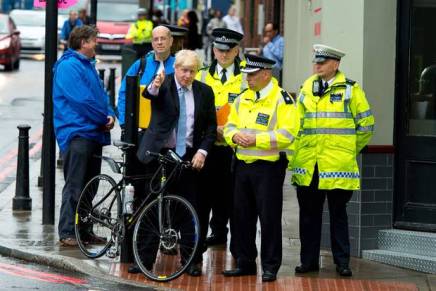 Mayor Johnson at launch of “mini-Operation Safeways” (Photo: Evening Standard)
Mayor Johnson at launch of “mini-Operation Safeways” (Photo: Evening Standard)
Yesterday Mayor Johnson announced a reprise of last winter’s “Operation Safeway” with claims that this policing programme will increase cyclist safety. We are very much in favour of law enforcement as a crucial element in reducing danger for cyclists and other road users – but we doubt that the “mini- Operation Safeways” announced will be it. Unless the lessons from Operation Safeway are learned – and there is no sign that they have been – TfL and MPS will continue to fail Londoners by not providing non-discriminatory and effective law enforcement. Here’s why:
The evidence on the effect of Operation Safeway: the first two months
Operation Safeway kicked off as a result of the spate of six cyclist deaths in autumn 2013. As we said the Mayor’s Cycling Commissioner, Andrew Gilligan, was quite correct in pointing out that this concentration of half the annual toll of London cyclist deaths into two weeks was highly unusual – but not an indicator that the death rate was increasing. It wasn’t.
“In the first half of 2013, only three cyclists died in London – one every two months. In the recent spate, it was every two days. Are these same streets 30 times more dangerous than just a few months ago?”
Unfortunately, Gilligan has since played the game he correctly criticises in assessing Operation Safeway. Earlier this year he said: “This operation has been hugely valuable … In the last eight weeks we have not seen one cyclist killed on London’s roads and dangerous behaviour has clearly dropped”.But it is quite expected that no cyclists are killed in two winter months. And where was the evidence that “dangerous behaviour has clearly dropped”?
The evidence on the effect of Operation Safeway: the picture now
The figures quoted by the Mayor, TfL and Gilligan yesterday are interesting. Essentially they point to a reduction in cyclist KSIs per journey in 2013. But:
(a) The 2013 reduction over 2012 cannot be due to Operation Safeway, which would only effect the last month of the year. Mayor Johnson claim of an effect due to “great work done by the police” are unfounded.
(b) Do we have good figures on the numbers of cyclist journeys taken in 2013 yet? It might be the case that there was a reduction in cyclist journeys in 2013, affected by a reduction the early months associated with the unusually cold weather in early 2013.
Both these points have been made clearly by our colleague Charlie Lloyd of the LCC.
The longer term evidence
Gilligan refers to a trend of reduced cyclist KSIs per cyclist journey in London over the last decade. We think he is right to point this out. He is also correct to point out that this has occurred simply due to the greater physical presence of cyclists, – an effect of adaptive behaviour (risk compensation) by motorists, sometimes referred to as “Safety in Numbers”.
But:
(a) This is a long term trend starting from the increase in cycling from the beginning of the century – it is not something which explains an alleged decline in KSI rate in 2013. You cannot seize on a figure for one year, even if it is correct. One year’s data done not indicate a trend.
(b) Gilligan refers to the very high cyclist death rate in 1989. As a somewhat long in the tooth transport professional I recall when the late John Devenport of the then London Accident Analysis Unit was required to analyse this particularly large figure. It was a very high figure – which went down in the years immediately afterwards. Avoid cherry picking figures…
(c) There are other reasons for casualties of all types going down – such as a tendency towards lower levels of societal risk taking associated with an economic downturn.
(d) Advocates of highlighting the effects of risk compensation (behavioural adaptation) such as ourselves do NOT suggest that increasing the numbers of people cycling is enough for cyclist safety. We require a change in culture which supports reduction in danger at source – from motor vehicular traffic – for the benefit of the safety of all road users. That has not happened in London.
(e) Advocates of highlighting the effects of risk compensation (behavioural adaptation) such as ourselves are pointing out the effects of spontaneous behavioural change. Beneficial changes have not been due to official “road safety” efforts: whether publicity campaigns, highway engineering (of which little for cyclists’ benefit has occurred), or indeed the limited policing which has happened.
(f) For Gilligan: “The presence of mass cycling on London’s roads has changed drivers’ behaviour.” That risk compensation ‘/ behavioral adaptation effect we think is true to some extent – but while there has been a significant increase in inner London (and not really “mass cycling” in a European sense) – it has not happened in outer London. This could be one of the reasons why there is a differential between outer and inner London cyclist KSIs after Operation Safeway.
What now?
To repeat, we are supporters of law enforcement programmes. But they have to be based on the right evidence and the right objectives. We do not think that Operation Safeway was indeed a “blitz” on unsafe driving. We do not think that there was a thorough programme of “getting dangerous drivers off the road”. As our next post shows, we think it was ill-informed and discriminatory.
We think that a very good and clear programme of what the MPS and TfL should do has been laid out by the London Cycling Campaign here , and we have suggested what we think should be happening here : real road safety, for the safety of cyclists and all road users.
.